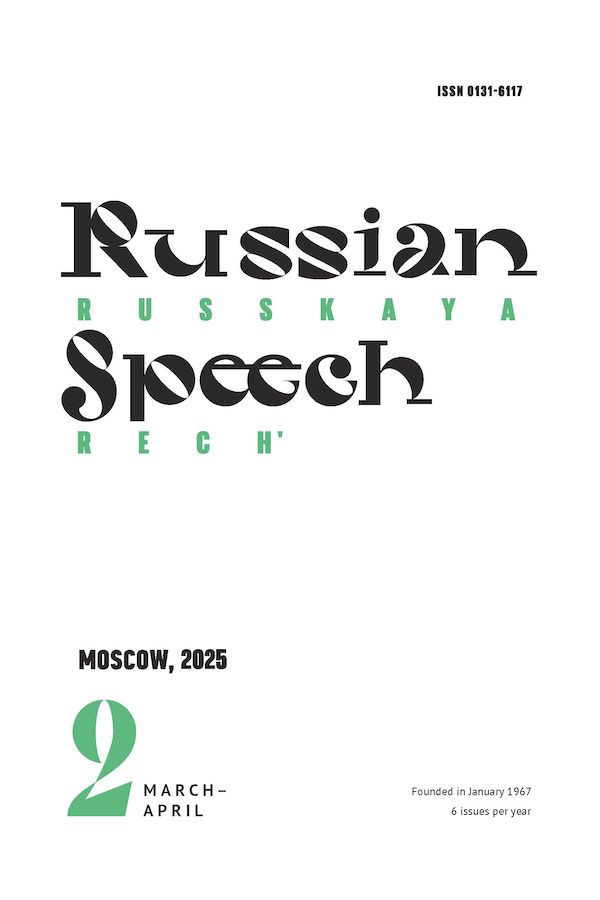The Pronunciation of Consonants Before the Letter e in the Words of Foreign Origin
- Authors: Veschikova I.A.1
-
Affiliations:
- Lomonosov Moscow State University
- Issue: No 4 (2023)
- Pages: 7-24
- Section: Articles
- URL: https://freezetech.ru/0131-6117/article/view/652355
- DOI: https://doi.org/10.31857/S013161170026389-6
- ID: 652355
Abstract
The continuous process of borrowing, proceeding with varying intensity and activating innovations from a particular language in certain epochs, requires constant attention to the orthoepy of this category of words by both non-specialists and phonetic scientists, including lexicographers. For this topic, the question of the pronunciation of the consonant before the letter e has always been and remains one of the most relevant, because, unlike native Russian words, where it indicates the softness of the preceding consonant, foreign-language borrowings in this regard are not the same: for some words, a soft consonant (term) will be correct, for others – a hard one (fake), for the third – the literary norm permits the use of both soft and hard consonants (aggression). How not to make a mistake in choosing the “right” consonant? The answer to this question is not at all simple, because: 1) the pronunciation of consonants before e (with the exception of the position of the end of unchangeable words) cannot be described using rules; 2) the general process of phonetic development of words like progress is contradictory and therefore does not exclude the updating of recommended norms; 3) a large number of lexicographic sources does not guarantee that the word of interest to the speaker will be fixed by them and provided with orthoepic instructions; 4) there is no consensus on the norm for a number of even common and at the same time long-standing borrowings; 5) when evaluating the option as correct, not only average native speakers, but also teachers do not always understand the nature of the differences between the two phenomena – the literary norm and the norm for working in the media. To learn the pronunciation of foreign words, the efforts of native speakers themselves are necessary (without studying scientific recommendations and observing the pronunciation of the word professionals can not do), and orthoepists (a resource similar to an academic Spelling project is needed).
References
- Анонс российского сериала «Квест» [Электронный ресурс]. URL: https://yandex.ru/video/preview/11664144508253483657 (дата обращения: 23.01.2023).
- Аванесов Р. И. Русское литературное произношение: Учеб. пособие для учительских институтов. М.: Государственное учебно-педагогическое издательство Министерства просвещения РСФСР, 1950. 159 с.
- Аванесов Р. И. Русское литературное произношение: Учеб. пособие для студ. пед. ин-тов по спец. № 2101 «Русский язык и литература». 6-е изд., перераб. и доп. М.: Просвещение, 1984. 384 с.
- Винокур Г. О. Русское сценическое произношение // Биография и культура. Русское сценическое произношение. М.: Русские словари, 1997. С. 97–173.
- Вторая мировая война. Фильм 3. Ленд-лиз. Документальный фильм. По заказу АО «ЦТВ». Производство: Студия Град (History Lab). © 2019К [Электронный ресурс]. URL: https://yandex.ru/video/preview/6600248956852591887 (дата обращения: 23.01.2023).
- Едличка А. Литературный язык в современной коммуникации // Новое в зарубежной лингвистике. Выпуск XX. Теория литературного языка в работах ученых ЧССР. М.: Прогресс, 1988. С. 38–134.
- Еськова Н. А. Рецензия на словари: М. В. Зарва «Русское словесное ударение» и Ф. Л. Агеенко «Собственные имена в русском языке. Словарь ударений» // Русский язык в научном освещении. 2004. № 1 (7). С. 272–278.
- Еськова Н. А. Надо ли писать каратэ? // Русская речь. 1991. № 3. С. 65–67.
- Зализняк А. А. Еще раз о жизни слов [Электронный ресурс]. URL: https://elementy.ru/nauchno-populyarnaya_biblioteka/433260/O_zhizni_slov (дата обращения: 23.01.2023).
- Касаткина Р. Ф. Новые лексические заимствования и русская орфоэпия // Культура русской звучащей речи: традиции и современность. Тезисы докладов международной научной конференции 26–28 апреля 2004 г. М.: ИРЯ им. В. В. Виноградова РАН, 2004. С. 67–70.
- Королева М. Подкаст «Чисто по-русски с Мариной Королевой». Выпуск 209, 1 сентября 2021 г. [Электронный ресурс]. URL: https://marinakoroleva.mave.digital/ep-209 (дата обращения: 23.01.2023).
- Ленд-лиз. Военная политэкономия. 2 серия. 2013. Россия, ОАО ТРК ВС РФ «Звезда» [Электронный ресурс]. URL: https://yandex.ru/video/preview/3800397213973554546 (дата обращения: 23.01.2023).
- Нечаева И. В. Актуальные проблемы орфографии иноязычных заимствований. М.: Издательский центр «Азбуковник», 2011. 168 с.
- Новиков В. Fake, фэйк, фейк [Электронный ресурс]. URL: https://svpressa.ru/culture/article/65834/ (дата обращения: 23.01.2023).
- Панов М. В. История русского литературного произношения XVIII–XX вв. / Ин-т рус. языка АН СССР; отв. ред. Д. Н. Шмелев. М.: Наука, 1990. 456 с.
- Панов М. В. Современный русский язык. Фонетика. М.: Высшая школа, 1979. 256 с.
- Правила русской орфографии и пунктуации. Полный академический справочник / Под ред. В. В. Лопатина. М.: Эксмо, 2009. 480 с.
- Успенский Б. А. История русского литературного языка (XI–XVIII вв.). Изд. 3-е, испр. и доп. М.: Аспект Пресс, 2002. 558 с.
- Ушаков Д. Н. Русская орфоэпия и ее задачи // Русская речь. Новая серия. III. Ленинград, 1928. С. 5–27.
- Шагалова Е. Н. Словарь новейших иностранных слов. М.: АСТ-ПРЕСС КНИГА, 2017. 576 с. (Настольные словари русского языка).
- Щерба Л. В. Транскрипция иностранных слов и собственных имен и фамилий // Труды комиссии по русскому языку. Т. 1. Л.: Изд-во АН СССР, 1931. С. 187–196.










